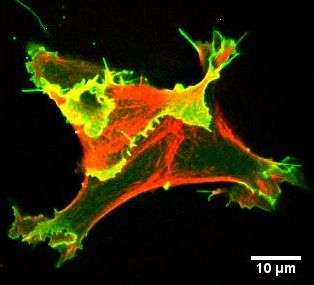Water governs cell movement

Water gives life. Researchers at Linköping University in Sweden now show how the cells in our bodies are driven mainly by water power – a discovery that in the long run opens the way for a new strategy in cancer therapy.
The ability of cells to move and change shape is significant in many biological processes. White blood corpuscles gather at "hotspots" like infections and inflammations. Stem cells in the embryo move off in different directions to make the organs of the body. One unwanted movement is the movement of tumour cells, which lead to cancer metastasis.
Cells have a clear leading and trailing edge and move by a broad, thin membrane protrusion shooting out in front while the rest of the cell follows it. Small, finger-like filopodia can also project out from the protrusion, probably a type of cellular antenna that senses the chemical environment – bacterial secretions, for example.
But what governs this ability to move? Water, say the Linköping research team, who set out their hypothesis in the scientific journal PLOS One.
For a cell to be able to initiate a movement there needs to be a complex interaction between the outer cell membrane and the cytoskeleton on the inside. One of the most important components is the protein actin, which has the ability to create dynamic fibres that can grow at one end and recede at the other. The current thinking is that, in this way, the membrane can push out and create the protrusions. But experiments and modelling have led the LiU researchers to another picture of the mechanism.
"We looked at how cells create the membrane protrusions they need in order to be able to move. We showed that the water flow out of and into the cells through water channels, or aquaporins, in the cell membrane is important," says Thommie Karlsson, researcher in medical microbiology and principal author of the article.
In order to study the process he and his colleagues used living cells which expressed the "fluorescent" protein GFP, attached to the aquaporin AQP9. It turned out that this water channel increased the movement capacity of the white blood cells, and also accumulated in the cell membrane where it promoted the formation of protrusions.
In models that were developed based on these results, the water flows through AQP9 in the cell where it creates an increased pressure between the cell membrane and the cytoskeleton. A protrusion forms, which is then anchored by actin fibres.
"This is a fundamentally new way of looking at cell movement. Our fellow researchers will try to disprove our results," says Professor Karl-Eric Magnusson, leader of the study.
The discovery in which aquaporin plays a crucial part opens the way to a new strategy to stop metastatic cancer tumours. There are 13 different types of aquaporin that react to different factors. By shutting off one or several with an inhibitor, we should be able to influence the movement of tumour cells, thereby preventing their spread through the body.
More information: Karlsson, T. et al. (2013) Fluxes of Water through Aquaporin 9 Weaken Membrane-Cytoskeleton Anchorage and Promote Formation of Membrane Protrusions. PLoS ONE 8(4): e59901. doi:10.1371/journal.pone.0059901
Journal information: PLoS ONE
Provided by Linköping University
















